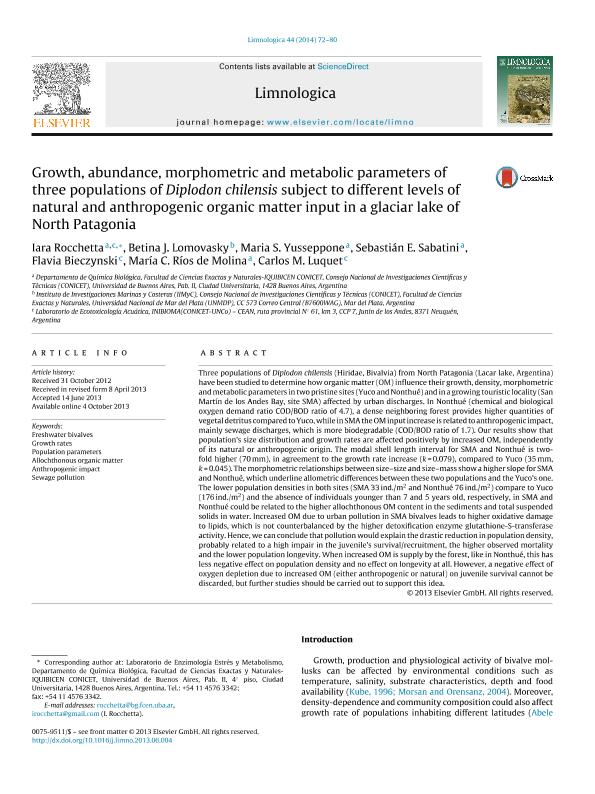Mostrar el registro sencillo del ítem
dc.contributor.author
Rocchetta, Iara

dc.contributor.author
Lomovasky, Betina Judith

dc.contributor.author
Yusseppone, Maria Soledad

dc.contributor.author
Sabatini, Sebastian Eduardo

dc.contributor.author
Bieczynski, Flavia

dc.contributor.author
Ríos de Molina, María C.
dc.contributor.author
Luquet, Carlos Marcelo

dc.date.available
2016-07-29T18:43:29Z
dc.date.issued
2013-06
dc.identifier.citation
Rocchetta, Iara; Lomovasky, Betina Judith; Yusseppone, Maria Soledad; Sabatini, Sebastian Eduardo; Bieczynski, Flavia; et al.; Growth, abundance, morphometric and metabolic parameters of three populations of Diplodon chilensis subject to different levels of natural and anthropogenic organic matter input in a glaciar lake of North Patagonia; Elsevier Gmbh; Limnologica; 44; 6-2013; 72-80
dc.identifier.issn
0075-9511
dc.identifier.uri
http://hdl.handle.net/11336/6819
dc.description.abstract
Three populations of Diplodon chilensis (Hiridae, Bivalvia) from North Patagonia (Lacar lake, Argentina) have been studied to determine how organic matter (OM) influence their growth, density, morphometric and metabolic parameters in two pristine sites (Yuco and Nonthué) and in a growing touristic locality (San Martín de los Andes Bay, site SMA) affected by urban discharges. In Nonthué (chemical and biological oxygen demand ratio COD/BOD ratio of 4.7), a dense neighboring forest provides higher quantities of vegetal detritus compared to Yuco, while in SMA the OM input increase is related to anthropogenic impact, mainly sewage discharges, which is more biodegradable (COD/BOD ratio of 1.7). Our results show that population’s size distribution and growth rates are affected positively by increased OM, independently of its natural or anthropogenic origin. The modal shell length interval for SMA and Nonthué is two-fold higher (70 mm), in agreement to the growth rate increase (k=0.079), compared to Yuco (35 mm, k=0.045). The morphometric relationships between size-size and size-mass show a higher slope for SMA and Nonthué, which underline allometric differences between these two populations and the Yuco’s one. The lower population densities in both sites (SMA 33 ind./m2 and Nonthue 76 ind./m2) compare to Yuco (176 ind./m2) and the absence of individuals younger than 7 and 5 years old, respectively, in SMA and Nonthué could be related to the higher allochthonous OM content in the sediments and total suspended solids in water. Increased OM due to urban pollution in SMA bivalves leads to higher oxidative damage to lipids, which is not counterbalanced by the higher detoxification enzyme glutathione-S-transferase activity. Hence, we can conclude that pollution would explain the drastic reduction in population density, probably related to a high impair in the juvenile’s survival/recruitment, the higher observed mortality and the lower population longevity. When increased OM is supply by the forest, like in Nonthue, this has less negative effect on population density and no effect on longevity at all. However, a negative effect of oxygen depletion due to increased OM (either anthropogenic or natural) on juvenile survival cannot be discarded, but further studies should be carried out to support this idea.
dc.format
application/pdf
dc.language.iso
eng
dc.publisher
Elsevier Gmbh

dc.rights
info:eu-repo/semantics/openAccess
dc.rights.uri
https://creativecommons.org/licenses/by-nc-nd/2.5/ar/
dc.subject
Freshwater Bivalves
dc.subject
Growth Rates
dc.subject
Population Parameters
dc.subject
Allochthonous Organic Matter
dc.subject
Anthropogenic Impact
dc.subject
Sewage Pollution
dc.subject.classification
Biología Marina, Limnología

dc.subject.classification
Ciencias Biológicas

dc.subject.classification
CIENCIAS NATURALES Y EXACTAS

dc.title
Growth, abundance, morphometric and metabolic parameters of three populations of Diplodon chilensis subject to different levels of natural and anthropogenic organic matter input in a glaciar lake of North Patagonia
dc.type
info:eu-repo/semantics/article
dc.type
info:ar-repo/semantics/artículo
dc.type
info:eu-repo/semantics/publishedVersion
dc.date.updated
2016-07-28T18:32:22Z
dc.journal.volume
44
dc.journal.pagination
72-80
dc.journal.pais
Alemania

dc.description.fil
Fil: Rocchetta, Iara. Consejo Nacional de Investigaciones Científicas y Técnicas. Oficina de Coordinación Administrativa Ciudad Universitaria. Instituto de Química Biológica de la Facultad de Ciencias Exactas y Naturales; Argentina. Consejo Nacional de Investigaciones Científicas y Técnicas. Centro Científico Tecnológico Mar del Plata. Instituto de Investigaciones Marinas y Costeras; Argentina
dc.description.fil
Fil: Lomovasky, Betina Judith. Consejo Nacional de Investigaciones Científicas y Técnicas. Centro Científico Tecnológico Mar del Plata. Instituto de Investigaciones Marinas y Costeras; Argentina
dc.description.fil
Fil: Yusseppone, Maria Soledad. Consejo Nacional de Investigaciones Científicas y Técnicas. Oficina de Coordinación Administrativa Ciudad Universitaria. Instituto de Química Biológica de la Facultad de Ciencias Exactas y Naturales; Argentina
dc.description.fil
Fil: Sabatini, Sebastian Eduardo. Consejo Nacional de Investigaciones Científicas y Técnicas. Oficina de Coordinación Administrativa Ciudad Universitaria. Instituto de Química Biológica de la Facultad de Ciencias Exactas y Naturales; Argentina
dc.description.fil
Fil: Bieczynski, Flavia. Consejo Nacional de Investigaciones Científicas y Técnicas. Centro Científico Tecnológico Patagonia Norte. Instituto de Investigación en Biodiversidad y Medioambiente; Argentina
dc.description.fil
Fil: Ríos de Molina, María C.. Consejo Nacional de Investigaciones Científicas y Técnicas. Oficina de Coordinación Administrativa Ciudad Universitaria. Instituto de Química Biológica de la Facultad de Ciencias Exactas y Naturales; Argentina
dc.description.fil
Fil: Luquet, Carlos Marcelo. Consejo Nacional de Investigaciones Científicas y Técnicas. Centro Científico Tecnológico Patagonia Norte. Instituto de Investigación en Biodiversidad y Medioambiente; Argentina
dc.journal.title
Limnologica

dc.relation.alternativeid
info:eu-repo/semantics/altIdentifier/url/http://www.sciencedirect.com/science/article/pii/S0075951113000753
dc.relation.alternativeid
info:eu-repo/semantics/altIdentifier/doi/10.1016/j.limno.2013.06.004
dc.relation.alternativeid
info:eu-repo/semantics/altIdentifier/doi/http://dx.doi.org/10.1016/j.limno.2013.06.004
Archivos asociados
